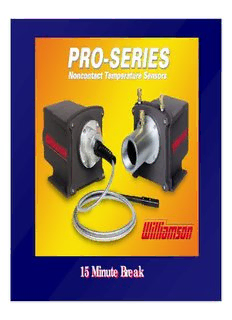
Infrared Thermometers also known as Pyrometers PDF
Preview Infrared Thermometers also known as Pyrometers
15 Minute Break Components of a Temperature Sensor • The Optics collect & focus the emitted energy onto a detector. Types of lenses include glass, quartz, achromat, germanium, and zinc. • The Filters optimize the operation of the sensor to selected energy wavelengths. • The Detector converts the infrared energy signal into an electrical signal. Common detectors include Ge, Si, InGaAs, Thermopile, PbS, PbSe, InAs. Temperature Range Sensor Type Optics Wavelength Infrared Thermometers •Brightness (a.k.a. Single-Wavelength or One-Color) •Ratio (a.k.a. Dual-Wavelength of Two-Color) •Multi-Variant ) (a.k.a. Multi-Wavelength or Other Three Sensor Types Brightness Sensor ε = constant Dual-wavelength sensor e-slope = ε /ε – 1 = constant 1 2 Multi-wavelength Sensor (Williamson) e-slope = f(ε ) 2 e-slope function is material specific Brightness Sensors Infrared Energy vs. Temperature Calibration Curve PRO 42 Auto Null Sensor Measured Temperature (°C) -17 8 33 58 83 108 133 158 183 208 233 258 283 308 333 358 383 408 433 458 483 508 533 0.14 0.12 ) ^20.10 m c s/0.08 t t a W 0.06 ( y g r0.04 e n E 0.02 0.00 0 50 100 150 200 250 300 350 400 450 500 550 600 650 700 750 800 850 900 950 1,00 0 Measured Temperature (°F) 2um Sensor Temperature Application Issues BACKGROUND HEATED TARGET REFLECTIONS FOV Target Area w/ Diameter (d) HEAT Field of View SOURCE (FOV) Intervening Media Working FOV Full FOV Distance (D) Target Partially Area Filled FOV SENSOR ΔT (System) = ΔT (Emissivity) + ΔT (Transmission) + ΔT (Background) + ΔT (Instrument) + ΔT (Alignment) Brightness Sensors • Tend to measure an average temperature value • Are affected by changes in emissivity, optical obstruction & stray background energy • Wavelength Matters! Why Wavelength Matters • Shorter Wavelengths are less sensitive to emissivity variation and optical obstruction. • Shorter wavelength readings are more highly weighted towards the hottest temperature viewed & longer wavelengths are less sensitive to hot reflections. • For low-emissivity materials, the emissivity is higher at a shorter wavelength, further reducing errors. • Wavelength selection is critical for viewing through steam, flames and products of combustion, for avoiding IR heater interference, and for measuring coated products.
Description: